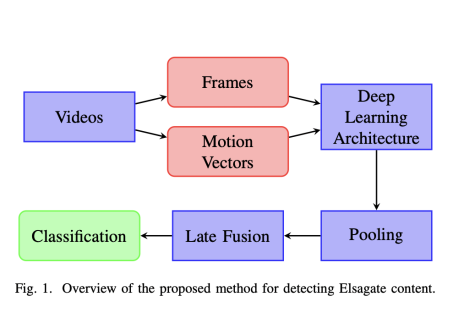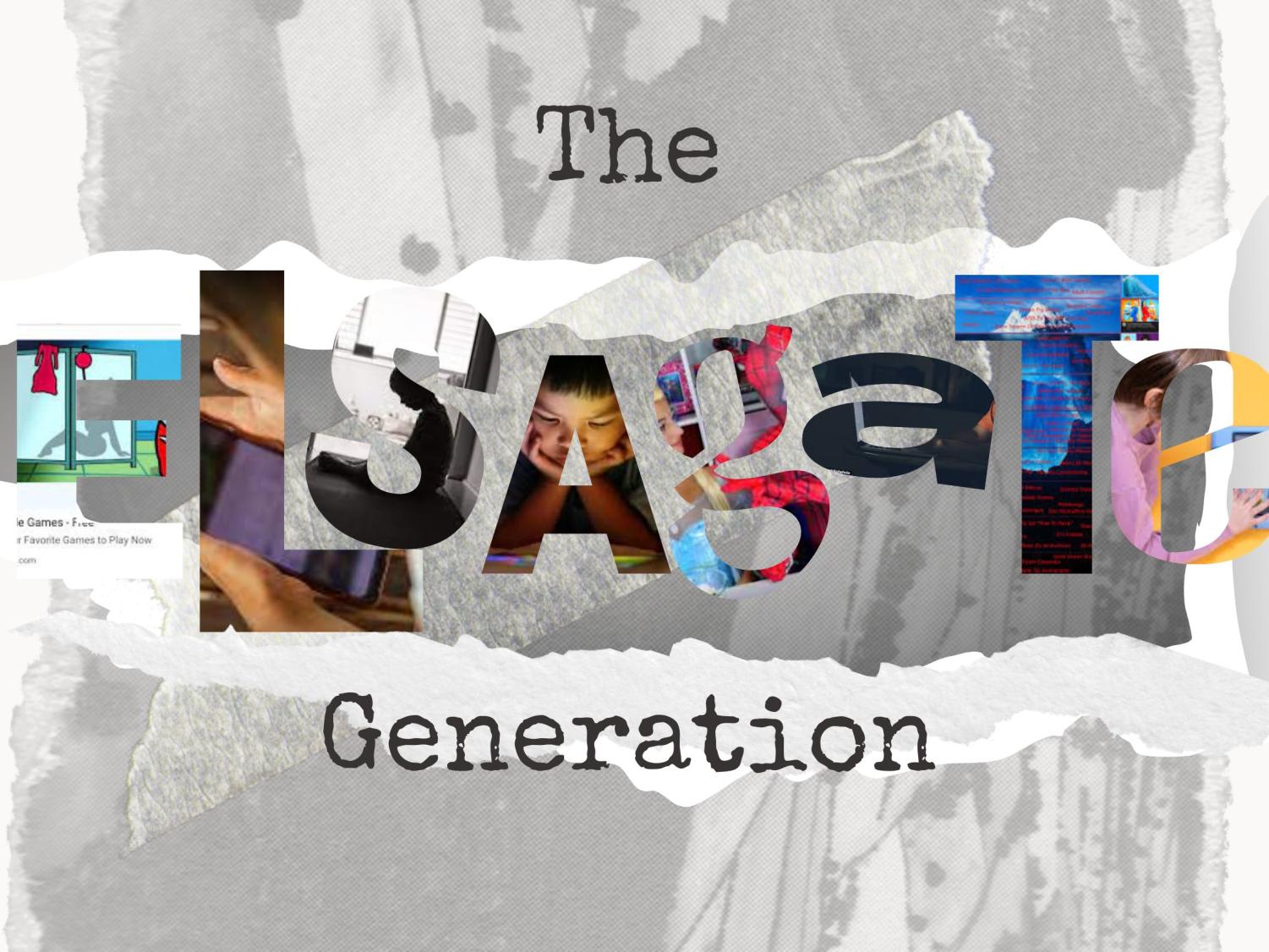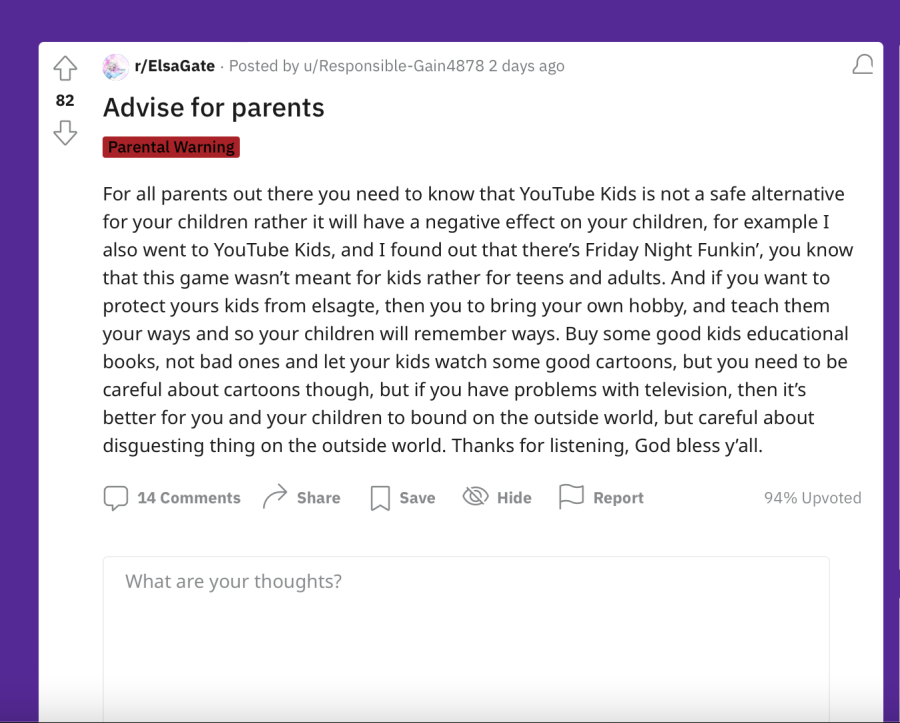Elsagate’s generation
May 11, 2023
2014. A child sits in a living room. They watch a video, something that their parents don’t quite understand. Understandable, considering all of the exceedingly bright and grotesque colors, the mashup of marketable faces such as Spiderman and Elsa and the nails-on-a-chalkboard level of annoying stock audio that fills any and all beats of silence. Besides, it keeps them busy. Rather the noisiness of Kevin MacLeod than the noisiness of a bored child.
While definitely not educational material, those videos made children incredibly happy. Something about adults, and in the beginning, their children, clothed in cheaply put-together costumes of their favorite cartoon characters acting out incredibly odd skits seemingly stimulates kids in a magical way; hook and sinker. That proved purposeful.
After the events of the Watergate scandal in the ‘70s, Americans developed the habit of naming any and every controversial scandal that arises in the media with the suffix of gate. In the case of the previously given scenario, journalists and media analysts donned the phenomena of Elsagate—intriguing, ominous and almost humorous. Extremely inconspicuous for it to engage with child predator rings globally.
Everything down to the odd characters, the babbling of nonsense, the sheer amount of references to feet, pregnancy and bodily excrements–all part of the grand scheme to lure children through psychology and projection of twisted adult fantasies. Especially considering that the majority of characters in the videos spoke in grunts and moans, the lack of a language barrier cultivated the breeding grounds for a worldwide audience. But, the children would not recognize the bait for what it stood for, considering the amount of innocence the mass majority of them carry. They just saw the incredible amount of views and wanted in.

“It really messed me up, you know? You’re not thinking about the ramifications of the injected fetishes or the misogyny or anything like that. You’re just a kid that really likes Spiderman with too much time on their hands, and you can’t really blame [oneself] for that,” senior Zaire Breedlove said.
Enter the influx of YouTube channels run by kids doing everything they can to mimic these trends in online media, and enter the twisted adults that capitalized on their naivety. ‘Barbie doll at the park’ videos transformed into face reveals, which turned into dancing requests. This transition did not fade away into obscurity, however; a couple of eagle-eyed parents and internet sleuths began finding a pattern within these videos.
The comments scattered around practically every video within the genre stood out as excessively weird. The gut reaction from the bulk of individuals consistently became to simply chalk it all up to young kids that didn’t understand how words worked, thus typing gibberish. But the nonsensical streams of letters and numbers gained a pattern. As in—they appeared in almost every single comment section, and, more importantly, playlists curated by pedophiles.
For those who did not have children but still possessed a child-like spirit, a go-to coping mechanism that hundreds still do today would simply revolve around watching old television shows and movies from their childhood. From “Hey Arnold!” to “Sabrina the Teenage Witch”, these child-friendly shows compiled into several binge-worthy playlists with added twists. For one, the titles of said playlists included dozens of tags—not unusual for channels wishing to beat the algorithm. What did stand out, however, included the sprinkles of young children in compromising situations and the very same repetitive cryptic codes found in the comments of the Elsagate content.
“Yeah, I totally had [spent] too much time on the internet [as a child]. The things I saw were truly, like, not cool at all and kinda reframed how I saw the rest of the world. I look back a lot at my childhood and go ‘Wow, I should have not known that’, but unfortunately I do because of a lot of sick people that continue to congregate online,” North Atlanta High School senior Chace Rumley said.
The pictorial boiling pot blew wide open after that discovery, bringing the topic of sadistic videos to the mainstream. The BBC, Guardian and several other papers began to run stories surrounding the new phenomena in 2017, despite its roots starting in the years prior. Big-time YouTubers, such as Phillip DeFranco, began to attack, alerting the public of the family channels that have abused their children all for the sake of ad revenue and views; this action proved especially important because the forms of media while starting in live-action format, had shifted to low-quality 2D animation and stop-motion films. Even China and Vietnam, the location of the juggernauts of the content farms banned YouTube, making sure to work around technological companies that provide firewalls to these bans. Ultimately, the sheer amount of public outrage transformed the Internet landscape into a safer one for children, hopefully.
But it already planted seeds of damage.
A common factoid in child psychology remains that the critical age range of development occurs between two to six years old—the primetime audience for the bulk of the Elsagate content. Again, the alarming and sadistic themes of violence, fetishes and general misery became part of thousands of children’s socialization, so they— the general age range of fresh adult Gen Zers— understood that the grotesque brutishness at such young ages became normalized. Combined with the underlying issue of adults expecting the Internet to raise their children and out comes the consistently reported quirk of Gen Z individuals behaving aloofly to graphic, massive amounts of trauma.
The effects dimmed in those who did not obtain such a connection to the internet as others, but the Web carries an infinite amount of dark corners, and they seriously altered the moral compass of millions of teens and young adults. Liveleak, a former site dedicated almost exclusively to snuff films, and Omegle, a randomized live chat setting where anyone can talk to anybody—even those they should not—continue to dominate these spheres of inherent human morbid curiosity. Fond memories that people hold on to about their childhood used to consist of educational cartoons, playing outside and general innocence. Now, the best people could have a combination of My Little Brony content made for adults, literal videos of terrorist decapitation and a plethora of other themes and experiences that children simply shouldn’t bear.
Elsagate content still exists. Even with all the previous outrage and attempts of extermination that platforms performed on the industry, it slithered out of its hole and adapted to its new environment.
“Unfortunately, inappropriate content that targets this demographic is also common. YouTube’s algorithmic recommendation system regrettably suggests inappropriate content because some of it mimics or is derived from otherwise appropriate content. Considering the risk for early childhood development, and an increasing trend in toddlers’ consumption of YouTube media, this is a worrisome problem….YouTube is still plagued by such disturbing videos and its currently deployed counter-measures are ineffective in terms of detecting them in a timely manner. Alarmingly, using our classifier we show that young children are not only able but likely to encounter disturbing videos when they randomly browse the platform starting from benign videos,” Boston University researcher Jeremy Blackburn said.

